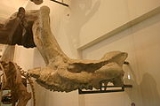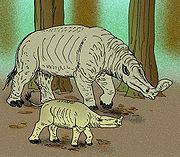
Embolotherium
Encyclopedia
Embolotherium is an extinct genus
of brontothere
that lived in Mongolia
during the late Eocene
period. It is most easily recognized by a large bony protuberance emanating from the anterior (front) end of the skull. This process resembles a battering ram
, thus providing the reason for the name Embolotherium. The animal is known from about 12 skull
s, several jaw
s, and a variety of other skeletal elements from the Ulan Gochu formation of Inner Mongolia
and the Irgilin Dzo of Outer Mongolia
.
. All known specimens have large rams. Therefore, coupled with the fact that the rams were hollow and fragile in comparison to the solid and sturdy horns of the North America
n brontotheres, such as Brontotherium
, it does not seem likely that the ram served as a weapon for contests between males. Rather, it might have had a non-sexual function, such as signaling to each other. The ram may have served as a specialized resonator
for sound production. This hypothesis is suggested by the fact that the bony nasal cavity
extends to the peak of the ram, thus implying that the nasal chamber was greatly elevated, possibly creating a resonating chamber.
 Several species
Several species
of Embolotherium have been named, including Embolotherium andrewsi, Embolotherium grangeri, Embolotherium louksi, Embolotherium ultimum, Embolotherium ergilensi, and Embolotherium efremovi. However, only two species, Embolotherium andrewsi and Embolotherium grangeri, appear to be valid. Other supposed species of Embolotherium are probably synonymous with these two species and were originally based on juvenile skulls, poorly preserved fossil material, or specimens that are not significantly different from either E. andrewsi or E. grangeri.
Another genus of brontothere, Titanodectes, which was named for several lower jaws found in the same sedimentary deposits as Embolotherium, probably represents the same beast as Embolotherium grangeri. Protembolotherium is another closely related genus from the Middle Eocene, which is distinguished by a noticeably smaller ram.
Genus
In biology, a genus is a low-level taxonomic rank used in the biological classification of living and fossil organisms, which is an example of definition by genus and differentia...
of brontothere
Brontotheriidae
Brontotheriidae, also called Titanotheriidae, is a family of extinct mammals belonging to the order Perissodactyla, the order that includes horses, rhinoceroses, and tapirs. Superficially they looked rather like rhinos, although they were not true rhinos and are probably most closely related to...
that lived in Mongolia
Mongolia
Mongolia is a landlocked country in East and Central Asia. It is bordered by Russia to the north and China to the south, east and west. Although Mongolia does not share a border with Kazakhstan, its western-most point is only from Kazakhstan's eastern tip. Ulan Bator, the capital and largest...
during the late Eocene
Eocene
The Eocene Epoch, lasting from about 56 to 34 million years ago , is a major division of the geologic timescale and the second epoch of the Paleogene Period in the Cenozoic Era. The Eocene spans the time from the end of the Palaeocene Epoch to the beginning of the Oligocene Epoch. The start of the...
period. It is most easily recognized by a large bony protuberance emanating from the anterior (front) end of the skull. This process resembles a battering ram
Battering ram
A battering ram is a siege engine originating in ancient times and designed to break open the masonry walls of fortifications or splinter their wooden gates...
, thus providing the reason for the name Embolotherium. The animal is known from about 12 skull
Skull
The skull is a bony structure in the head of many animals that supports the structures of the face and forms a cavity for the brain.The skull is composed of two parts: the cranium and the mandible. A skull without a mandible is only a cranium. Animals that have skulls are called craniates...
s, several jaw
Jaw
The jaw is any opposable articulated structure at the entrance of the mouth, typically used for grasping and manipulating food. The term jaws is also broadly applied to the whole of the structures constituting the vault of the mouth and serving to open and close it and is part of the body plan of...
s, and a variety of other skeletal elements from the Ulan Gochu formation of Inner Mongolia
Inner Mongolia
Inner Mongolia is an autonomous region of the People's Republic of China, located in the northern region of the country. Inner Mongolia shares an international border with the countries of Mongolia and the Russian Federation...
and the Irgilin Dzo of Outer Mongolia
Outer Mongolia
Outer Mongolia was a territory of the Qing Dynasty = the Manchu Empire. Its area was roughly equivalent to that of the modern state of Mongolia, which is sometimes informally called "Outer Mongolia" today...
.
Fossils
Complete skeletons of Embolotherium have not yet been recovered, but if one compares the skulls to other brontotheres, it was probably about 2.5 metres (8.2 ft) tall at the shoulder. Unlike many of the other Late Eocene brontotheres, there is no clear evidence that Embolotherium was sexually dimorphicSexual dimorphism
Sexual dimorphism is a phenotypic difference between males and females of the same species. Examples of such differences include differences in morphology, ornamentation, and behavior.-Examples:-Ornamentation / coloration:...
. All known specimens have large rams. Therefore, coupled with the fact that the rams were hollow and fragile in comparison to the solid and sturdy horns of the North America
North America
North America is a continent wholly within the Northern Hemisphere and almost wholly within the Western Hemisphere. It is also considered a northern subcontinent of the Americas...
n brontotheres, such as Brontotherium
Brontotherium
Brontotherium is an extinct genus of prehistoric odd-toed ungulate mammal of the family Brontotheriidae, an extinct group of rhinoceros-like browsers related to horses. The genus was found in North America during the Late Eocene....
, it does not seem likely that the ram served as a weapon for contests between males. Rather, it might have had a non-sexual function, such as signaling to each other. The ram may have served as a specialized resonator
Resonator
A resonator is a device or system that exhibits resonance or resonant behavior, that is, it naturally oscillates at some frequencies, called its resonant frequencies, with greater amplitude than at others. The oscillations in a resonator can be either electromagnetic or mechanical...
for sound production. This hypothesis is suggested by the fact that the bony nasal cavity
Nasal cavity
The nasal cavity is a large air filled space above and behind the nose in the middle of the face.- Function :The nasal cavity conditions the air to be received by the other areas of the respiratory tract...
extends to the peak of the ram, thus implying that the nasal chamber was greatly elevated, possibly creating a resonating chamber.
Other Relatives

Species
In biology, a species is one of the basic units of biological classification and a taxonomic rank. A species is often defined as a group of organisms capable of interbreeding and producing fertile offspring. While in many cases this definition is adequate, more precise or differing measures are...
of Embolotherium have been named, including Embolotherium andrewsi, Embolotherium grangeri, Embolotherium louksi, Embolotherium ultimum, Embolotherium ergilensi, and Embolotherium efremovi. However, only two species, Embolotherium andrewsi and Embolotherium grangeri, appear to be valid. Other supposed species of Embolotherium are probably synonymous with these two species and were originally based on juvenile skulls, poorly preserved fossil material, or specimens that are not significantly different from either E. andrewsi or E. grangeri.
Another genus of brontothere, Titanodectes, which was named for several lower jaws found in the same sedimentary deposits as Embolotherium, probably represents the same beast as Embolotherium grangeri. Protembolotherium is another closely related genus from the Middle Eocene, which is distinguished by a noticeably smaller ram.
In popular culture
- Embolotherium appeared in PrimevalPrimevalPrimeval or primæval may refer to:* Primeval, a British science fiction television series.* Primeval , a 2007 film* Primeval , a score of music from the BBC TV series Doctor Who...
Series 3 Episode 9 and Walking with BeastsWalking with BeastsWalking with Beasts is a 2001 six-part television documentary miniseries, produced by the BBC in the United Kingdom, narrated by Kenneth Branagh. In North America it has been retitled Walking with Prehistoric Beasts, and the original Discovery Channel broadcast was narrated by Stockard Channing...
, although in some dubs, or in translations of the series' companion book, it was called Brontothere.

